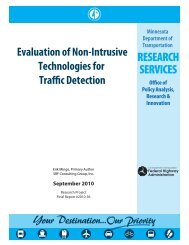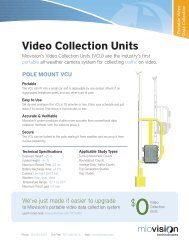Outsourcing Traffic Data Collection - Miovision Technologies
Outsourcing Traffic Data Collection - Miovision Technologies
Outsourcing Traffic Data Collection - Miovision Technologies
Create successful ePaper yourself
Turn your PDF publications into a flip-book with our unique Google optimized e-Paper software.
<strong>Outsourcing</strong><br />
<strong>Traffic</strong> <strong>Data</strong> <strong>Collection</strong><br />
Research Initiative
In July 2012, we reached out to engineering firms across North<br />
America to take part in <strong>Miovision</strong>’s next research initiative about<br />
outsourcing manual data collection.<br />
This research initiative consisted of six questions about how<br />
engineering firms are using manual data collection vendors,<br />
the frequency, hurdles and solutions in the data collection<br />
process. All of the feedback has been reviewed and compiled<br />
into the report below. Other engineering firms can use this to<br />
gain insight into what firms are experiencing with outsourcing<br />
manual data collection and as a benchmark.<br />
Summary of Questions<br />
1. How many data collection projects do you have annually (in-house and outsourced combined)?<br />
2. How often do you outsource data collection annually?<br />
3. How much administrative time do you spend per project on outsourcing data collection? This includes total time<br />
requesting data/quotes, accessing data, validating data, etc.<br />
4. What is the collected data being used for? (signal timing, corridor studies, retail project, etc.)<br />
5. What hurdles do you experience with outsourcing to manual data collectors?<br />
6. How have you solved these hurdles in the past?<br />
Summary of Findings<br />
For this research initiative on outsourcing manual data collection, there was a wide array of responses for many of the<br />
questions.<br />
Total data collection and manual outsourced data collection results show that the majority of respondents are on either ends<br />
of the spectrum. Either they are doing little or most of their data collection using a vendor and have either very many or few<br />
data collection projects annually.<br />
Results show that most data collection coordination (88%) takes less than a day. It’s applied to various projects, most of<br />
which are signal timing, corridor studies and traffic impact analysis (71% of respondents). The hurdles experienced surround<br />
coordination and quality/validation of manually collected data. To overcome these hurdles, firms better manage the process<br />
and relationship with the vendor.<br />
| 1
Question 1:<br />
How many data collection projects do you have annually (in-house and outsourced combined)?<br />
The first question was to establish the amount of total traffic data collection on an annual basis. Based on the chart below, we<br />
received a wide variety of responses. About a quarter of respondents complete five or less projects a year. Another quarter<br />
indicated that they complete over 20 projects a year.<br />
It appears that the majority of engineering firms, about 67%, complete 15 or less data collection projects annually. These<br />
results include both in-house and outsourced manual data collection.<br />
Annual <strong>Data</strong> <strong>Collection</strong> Projects<br />
over 25over 25<br />
24%<br />
26%<br />
21-25<br />
2%<br />
7%<br />
22%<br />
19%<br />
16-20<br />
11-15<br />
6-10<br />
1-5<br />
Question 2:<br />
How often do you outsource data collection annually?<br />
The chart below shows the amount of outsourced manual data collection by engineering firms. Once again, there is a wide<br />
range of responses. It appears that the majority either use outsourced manual data collection most of the time or very little of<br />
the time – not much middle ground.<br />
About 38% of respondents indicated that they use outsourced data collection less than 30% of the time. On the other hand,<br />
about 40% of respondents indicated that they use outsourced manual data collection over 70% of the time.<br />
Having such polar opposites indicate that in most instances firms either have:<br />
• An established data collection team – can use vendors for additional capacity or for inopportune locations<br />
OR<br />
• Limited technicians or other staff than complete data collection – predominately use vendors unless the project is smaller<br />
or a vendor is not available for the project<br />
| 2
Annual Outsourced Manual <strong>Data</strong> <strong>Collection</strong><br />
90-100%<br />
80-89%<br />
70-79%<br />
60-69%<br />
50-59%<br />
40-49% (none)<br />
30-3%9<br />
20-29%<br />
10-19%<br />
0-9%<br />
Question 3:<br />
How much administrative time do you spend per project on outsourcing data collection?<br />
The chart below indicates the amount of time engineering firms are spending on coordinating outsourced manual data<br />
collection. This includes total time requesting data/quotes, accessing data, validating data, and so on.<br />
The majority of respondents, about 88%, indicate that total coordination and administrative time is less than a day for<br />
outsourcing manual data collection. Based on the chart below, 30% of respondents stated it takes less than an hour while<br />
another 30% stated it takes about 2-3 hours for coordination.<br />
Amount of Admin Time for <strong>Outsourcing</strong><br />
30%<br />
25%<br />
20%<br />
15%<br />
10%<br />
Frequency<br />
5%<br />
0%<br />
Week<br />
| 3
Question 4:<br />
What is the collected data being used for?<br />
This question was aimed to see what types of projects or traffic studies are being outsourced to manual traffic data collection<br />
vendors. As the chart below indicates, there is a wide range of applications, including:<br />
• Signal Timing<br />
• Corridor Studies<br />
• <strong>Traffic</strong> Impact Analysis<br />
• AADT or Volume Count Studies<br />
• Origin-Destination<br />
• Travel Time<br />
• Warrant Analysis<br />
• Safety Studies<br />
• Capacity Analysis<br />
• Calibration<br />
• Retail Projects<br />
The most common traffic studies are signal timing, corridor studies and traffic impact analysis. About 71% of our respondents’<br />
outsourced manual data collection projects were for these top three types of studies.<br />
Purpose for <strong>Data</strong> <strong>Collection</strong><br />
25%<br />
Retail Projects<br />
20%<br />
Calibration<br />
15%<br />
Capacity Analysis<br />
Safety<br />
10%<br />
Frequency<br />
Warrant Analysis<br />
5%<br />
Travel Time<br />
0%<br />
Signal Timing<br />
Corridor Studies<br />
<strong>Traffic</strong> Impact Studies<br />
AADT/Volume Studies<br />
Origin-Destination<br />
Travel Time<br />
Warrant Analysis<br />
Safety<br />
Capacity Analysis<br />
Calibration<br />
Retail Projects<br />
OD Studies<br />
AADT/Volume Studies<br />
<strong>Traffic</strong> Impact Studies<br />
Corridor Studies<br />
Signal Timing<br />
| 4
Question 5:<br />
What hurdles do you experience with outsourcing to manual data collectors?<br />
Working with an outsourced manual data collection vendor can pose a number of challenges. This question was aimed to<br />
determine what types of hurdles our respondents are experiencing when working with vendors in their manual data collection<br />
projects.<br />
According to the chart below, the most common hurdles experienced are in relation to time/coordination as well as manual<br />
data quality/validation. These hurdles were experienced by over 57% of respondents.<br />
On the other hand, cost was the least experienced hurdle with only 4% of respondents citing this as an issue.<br />
Outsourced Manual <strong>Data</strong> <strong>Collection</strong> Hurdles<br />
35%<br />
Varible Pricing/<strong>Data</strong><br />
30%<br />
Location/Weather<br />
25%<br />
Manpower<br />
20%<br />
Reliability<br />
15%<br />
10%<br />
Frequency<br />
Little/No Hurdles<br />
5%<br />
Quality/Validation<br />
0%<br />
Time/Cooridnation<br />
Cost<br />
Quality/Validation<br />
Little/No Hurdles<br />
Reliability<br />
Manpower<br />
Location/Weather<br />
Variable Pricing/<strong>Data</strong><br />
Cost<br />
Time/Coordination<br />
| 5
Question 6:<br />
How have you solved these hurdles in the past?<br />
When we asked respondents how they solved the above hurdles, we received a lot of different answers. It appears that the<br />
most common response is to manage manual data collection by having more input/control into the process.<br />
The top solutions were:<br />
• Renegotiating the contract/project (23%)<br />
• Providing training (23%)<br />
• Limiting outsourcing or the amount of vendors used (19%)<br />
These top solutions accounted for 65% of respondents. Interestingly enough, the fourth solution was to bring data collection<br />
in-house with 15% of respondents indicating this.<br />
Manual <strong>Data</strong> <strong>Collection</strong> Hurdle Solutions<br />
25%<br />
Redo Counts<br />
20%<br />
Training<br />
15%<br />
Limited <strong>Outsourcing</strong><br />
Frequency<br />
Adusting Timelines<br />
10%<br />
Renegotiated Project<br />
5%<br />
No Solution<br />
0%<br />
In-House<br />
No Solution<br />
Renegotiated Project<br />
Adjusting Timelines<br />
Limited <strong>Outsourcing</strong><br />
Training<br />
Redo Counts<br />
In-House<br />
| 6
Conclusion<br />
Utilizing outsourcing manual data collection for transportation projects can vary greatly from vendor to vendor. Any data<br />
that is questionable or inaccurate can have serious consequences for engineering firms, the cities where the project is<br />
located and the residents. Based on the results, data is being applied for signal timing, development and expansion projects<br />
and infrastructure planning. Any inaccurate data could significantly impact the results of these projects, whether it is poor<br />
planning/execution, inefficient transportation network, increased congestion or higher levels of air pollution due to vehicle<br />
emissions.<br />
<strong>Miovision</strong> has introduced <strong>Traffic</strong> <strong>Data</strong> On Demand – an online traffic data solution for traffic engineers to request, receive and<br />
manage traffic data for almost any location in the United States and Canada. <strong>Data</strong> is collected using our automated solutions<br />
through our Partner Network. The entire process is streamlined to ensure the highest quality of data with the least amount of<br />
hassle.<br />
<strong>Traffic</strong> <strong>Data</strong> On Demand provides users with control of their budget, quality and timelines.<br />
Research was collected and published by <strong>Miovision</strong> <strong>Technologies</strong> Inc.,<br />
with the permission of survey respondents.<br />
This data and the entire contents of this report are copyrighted by<br />
<strong>Miovision</strong> <strong>Technologies</strong> Inc., September 2012.<br />
© 2012, <strong>Miovision</strong> <strong>Technologies</strong> Inc. All rights reserved.<br />
www.miovision.com<br />
| 7





